Implementing Fuel-Efficient Vehicles
Switching to fuel-efficient vehicles not only represents a savvy financial move for companies, but it's also an essential step in contributing to environmental sustainability. The benefits of adopting hybrid and electric vehicles can dramatically affect operational costs while paving the way for a greener future. This approach demonstrates a business commitment to better resource allocation and responsibility toward environmental control.
Choosing the Right Vehicles
When assessing which vehicles will work best for your fleet, it’s crucial to start with informed decisions. Studies indicate that hybrid vehicles can reduce fuel consumption by up to 30%. They provide an excellent balance between traditional gas engines and full-electric systems. For fleets needing extensive range capabilities without prohibitive recharging times, hybrids offer an attractive solution. Meanwhile, fully electric vehicles (EVs) offer the ultimate savings on fuel since they run on electricity instead of gas, cutting costs to zero when it comes to refueling. However, the initial investment in electric vehicles can be steep but justifiable, especially when considering compliance with future environmental regulations.
Conducting an analysis of your current fleet is critical. Identify which vehicles consume the most fuel and think strategically about replacements. Once you have a clear picture, explore government subsidies and grants. Numerous jurisdictions now offer substantial incentives for businesses making the shift toward greener technologies, helping offset those higher upfront costs associated with hybrid or electric vehicle purchases. This proactive use of financial resources supports long-term sustainability goals.
Several companies have set exemplary benchmarks in this regard. For instance, FedEx's ambitious goal to build an entirely electric fleet by 2040 highlights a commitment to increasing efficiency while meeting sustainability targets. They initiated this transformative process by phasing out their most inefficient vehicles first—a strategy any fleet operator could learn from.
Transition Plan
To ease into this transition, consider these practical steps:
- Identify High Consumers: Review your existing fleet data to identify which vehicles are consuming the most fuel.
- Analyze Replacement Options: Research hybrids or EV models that fit operational needs and evaluate their cost-benefit analyses.
- Explore Financial Assistance: Look into local or federal grants aimed at supporting environmentally friendly transportation options; these incentives could make your upgrade plans more financially feasible.
Each step serves as a building block towards establishing a more sustainable fleet operation while actively contributing to reducing greenhouse gas emissions. Implementing a robust fuel management system will further streamline these efforts by offering detailed tracking and compliance solutions.
Investing in fuel-efficient vehicles is just one part of optimizing your fleet's performance; effective monitoring and management practices are equally important in maximizing savings and sustainability efforts moving forward. An integrated platform that focuses on strategic fuel management and instantaneous alerts allows businesses to maintain more control over their operational efficiencies.
Leveraging Fleet Management Software
Fleet management software is more than just a tech upgrade; it’s a smart investment in efficiency that pays dividends. At its core, this type of software provides data-driven insights that can help fleet managers better monitor fuel usage and streamline their operations within the industry. By increasing visibility into fleet operations, managers can minimize the risk of breakdowns and other issues that could disrupt service.
Imagine having a dashboard that not only tracks where your vehicles are but also shows you how efficiently they're running. That’s precisely what modern fleet management solutions, with enhanced functionality such as fuel card integration, can do for your organization.
Key Features to Look For
When evaluating fleet management software, there are essential features that can dramatically influence your fuel efficiency and overall operational success.
Important Features:
- GPS tracking: This feature allows for real-time monitoring of vehicle locations and route efficiency. Understanding which routes are the most fuel-efficient enables managers to implement changes to reduce unnecessary travel. If one driver consistently takes longer routes, a quick conversation might save both time and gas, reducing the risk of inefficiencies.
- Fuel usage reports: Fuel insight tools provide valuable data on consumption patterns, helping identify inefficiencies and potential issues. Look for reports revealing fuel consumption per trip or by individual vehicles. Incorporating a fuel card system can offer further insights into spending and efficiency, enabling proactive behavior adjustments, such as reducing idling time or optimizing driving habits.
- Maintenance scheduling tools: Keeping vehicles in peak condition directly influences fuel economy and reduces the risk of breakdowns. Fleet management software that automates reminders for maintenance checks ensures your vehicles run smoothly—after all, a well-maintained vehicle is a more efficient one.
Companies utilizing fleet management systems have found impressive statistics: many report fuel savings of up to 15%. This reduction could translate into significant cost savings over time, which is critical in an industry focused on efficiency and profitability.
Consider companies like Walmart, which implemented telematics devices across their fleet. The result? They reduced idle time by 20%, leading to substantial decreases in fuel expenses, demonstrating reduced risk and increased visibility. This practical application shows that technology paired with strategy can yield remarkable results.
As vital as software solutions are in managing efficiencies, it’s equally crucial to focus on maintaining the physical state of your vehicles to ensure peak performance. Let's explore the importance of keeping up-to-date with regular service schedules and other maintenance practices.
Prioritizing Regular Maintenance
When it comes to running a fleet, one vital aspect shouldn't be overlooked: regular maintenance. This isn't just about keeping vehicles looking good; it's a crucial strategy that enhances fuel efficiency while also extending the lifespan of each vehicle. Think about the engine—if it’s not running properly, fuel consumption naturally increases. Poorly maintained engines can drag down your entire operation’s productivity.
It’s surprising how factors like underinflated tires or clogged air filters can sneak up on your fuel efficiency. Neglected components can decrease fuel efficiency by as much as 10%. Picture your fleet vehicles struggling against everyday road stresses—a worn-out engine can't perform optimally, leading to increased fuel costs. Adhering to a consistent maintenance schedule becomes essential for any fleet manager aiming to minimize breakdowns and other operational issues.
Maintenance Tips
For actionable steps that ensure your fleet remains fuel-efficient, let's start with tire management. Checking tire pressure weekly might sound simple, yet it's a foundational practice that can yield substantial savings. Underinflated tires create more rolling resistance on the road, leading to higher fuel consumption over time. This small effort can make a big difference; studies show that maintaining proper tire pressure can improve fuel efficiency by around 3% to 4% for your organization.
Moving forward, make replacing air filters part of your routine—consider changing them every 15,000 to 30,000 miles as recommended by experts. A clean air filter allows the engine to breathe easier and perform efficiently, reducing energy drawn from the fuel stored in its tank. This simple practice, when integrated into your overall maintenance strategy, can be further enhanced by leveraging fuel management software. Such tools offer services and expertise in monitoring fuel usage, enabling a more comprehensive approach to fleet maintenance.
Companies like UPS have harnessed the benefits of an extensive preventive maintenance schedule, achieving remarkable outcomes—fuel savings amounting to three million gallons annually! Imagine the advantages you could realize by utilizing fuel management software to track and manage fuel consumption, minimizing instances of fuel theft which can often occur at gas stations.
However, don't stop there—establish clear protocols for regularly scheduled checks that include mechanical inspections and comprehensive fluid level checks. Engaging employees ensures everyone knows their role in keeping vehicles well-maintained and operational. The integration of technology, like fuel management software, can provide real-time insights and facilitate effective coordination among team members.
Beyond these practical measures, understanding how driver behavior influences fuel efficiency can open new avenues for savings and improvements. A dedicated page on your company's intranet or website could serve as a central resource for sharing tips and updates on maximizing fuel efficiency.
Educating Drivers for Fuel Efficiency
Driver behavior plays a significant role in how much fuel a fleet consumes. Studies show that aggressive driving habits—like speeding, rapid acceleration, and sudden braking—can dramatically decrease fuel efficiency. In fact, the American Transportation Research Institute found that these behaviors can lower highway fuel efficiency by up to 33% and reduce city fuel efficiency by about 5%. Understanding this impact is the first step towards fostering environments where good driving practices are prioritized.
Training Programs
Implementing training programs focused on eco-driving techniques can lead to impressive improvements in fuel savings. These techniques emphasize smooth acceleration and deceleration, encouraging drivers to maintain a steady speed. This not only helps conserve fuel but also minimizes wear and tear on engines.
By incorporating telematics data into training sessions, fleets can provide personalized feedback tailored to each driver. For instance, if a driver's data indicates frequent hard braking or rapid acceleration, targeted training can specifically address those habits with real data to support the changes needed.
Adopting such strategies can yield substantial savings; Schneider National—a logistics leader—noted a 10% improvement in fuel efficiency after rolling out their driver education initiative.
Additionally, ongoing education should be paired with regular feedback on driving habits. This continuous coaching ensures that drivers are aware of their behaviors in real time and allows them to make adjustments quickly. Feedback loops help reinforce positive habits while providing an opportunity for drivers to ask questions and discuss challenges they may encounter on the road. Simple reminders about techniques for smoother operations could make all the difference in performance.
Equipping drivers with proper knowledge and spotting negative patterns early can significantly cut down on unnecessary fuel costs—but there's another layer to consider regarding how strategic selections impact these savings even further. Investing in fuel management software adds another dimension to your strategy by minimizing vulnerabilities like fuel theft and maximizing operational efficiency.

